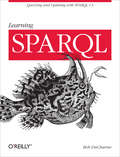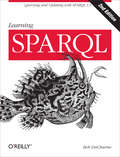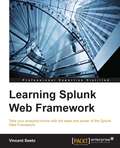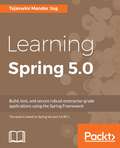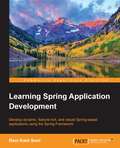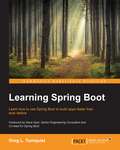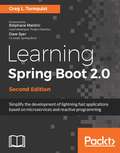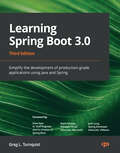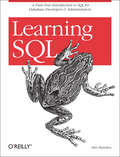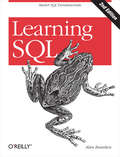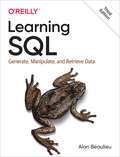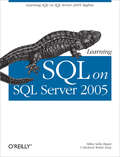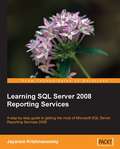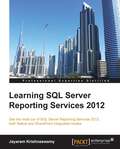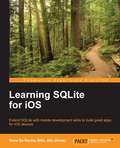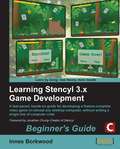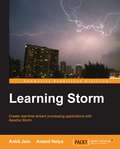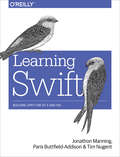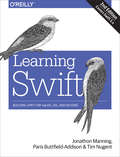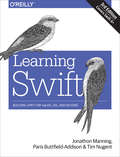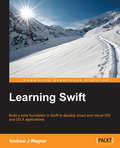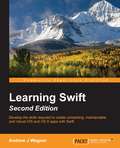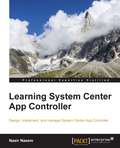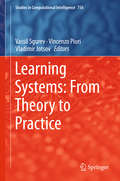- Table View
- List View
Learning SPARQL
by Bob DuCharmeGet hands-on experience with SPARQL, the RDF query language that's become a key component of the semantic web. With this concise book, you will learn how to use the latest version of this W3C standard to retrieve and manipulate the increasing amount of public and private data available via SPARQL endpoints. Several open source and commercial tools already support SPARQL, and this introduction gets you started right away.Begin with how to write and run simple SPARQL 1.1 queries, then dive into the language's powerful features and capabilities for manipulating the data you retrieve. Learn what you need to know to add to, update, and delete data in RDF datasets, and give web applications access to this data.Understand SPARQL’s connection with RDF, the semantic web, and related specificationsQuery and combine data from local and remote sourcesCopy, convert, and create new RDF dataLearn how datatype metadata, standardized functions, and extension functions contribute to your queriesIncorporate SPARQL queries into web-based applications
Learning SPARQL: Querying and Updating with SPARQL 1.1
by Bob DucharmeGet hands-on experience with SPARQL, the RDF query language that's become a key component of the semantic web. With this concise book, you will learn how to use the latest version of this W3C standard to retrieve and manipulate the increasing amount of public and private data available via SPARQL endpoints. Several open source and commercial tools already support SPARQL, and this introduction gets you started right away. Begin with how to write and run simple SPARQL 1.1 queries, then dive into the language's powerful features and capabilities for manipulating the data you retrieve. Learn what you need to know to add to, update, and delete data in RDF datasets, and give web applications access to this data. Understand SPARQL's connection with RDF, the semantic web, and related specifications Query and combine data from local and remote sources Copy, convert, and create new RDF data Learn how datatype metadata, standardized functions, and extension functions contribute to your queries Incorporate SPARQL queries into web-based applications
Learning Splunk Web Framework
by Vincent SestoTake your analytics online with the ease and power of the Splunk Web Framework About This Book * Want to build rich applications on the Web using Splunk? This book will be your ultimate guide! * Learn to use web framework components with the help of this highly practical, example-rich guide * Perform excellent Splunk analytics on the Web and bring that knowledge to your own projects Who This Book Is For This book will cater to Splunk developers and administrators who now wish to further their knowledge with Splunk Web Framework and learn to improve the way they present and visualize data in Splunk. A basic knowledge of JavaScript will be beneficial but is not a prerequisite. What You Will Learn * Master the fundamentals of Splunk Web Framework * Start thinking of Splunk as a complete development platform to build user-friendly apps * Extend the functionality of your apps using SimpleXML techniques * Set up dashboard layouts, navigation, and menus in your apps * Create simple dashboard elements including charts and tables * Master the art of interacting with searches and dashboards * Integrate SplunkJS to add visual appeal to your website In Detail Building rich applications on the Web using Splunk is now simpler than ever before with the Splunk Web Framework. It empowers developers to build their own web applications with custom dashboards, tables, charts, form searches, and other functionalities in the datasets at their disposal. The book will start with the fundamentals of the Splunk Web Framework, teaching you the secrets of building interesting and user-friendly applications. In the first application, you will learn to analyze and monitor traffic hitting the NASA website and learn to create dashboards for it. You will then learn additional, and more detailed, techniques to enhance the functionalities of the app such as dashboards and forms, editing simple XML, using simple XML extensions, tokens, post-process searches, dynamic drill-downs, the Splunk Web Framework and REST API, and much more. The second app will use historical stock market data and will create custom dashboards using Splunk Web Framework; the book will now cover important topics such as creating HTML dashboards, enhancing the visual appeal of the app using CSS, and moving your app with SplunkJS. The book will provide different and interesting examples instead of the usual "Log, Index, Search, and Graph" so that Splunk will be the first tool readers think of to resolve a problem. Style and approach This book will follow a step-by-step approach whereby every new concept is built on top of the previous chapter, and will be highly practical in nature; the reader will learn to build apps while reading about the Splunk Web framework.
Learning Spring 5.0
by Tejaswini Mandar JogBuild, test, and secure robust enterprise-grade applications using the Spring Framework About This Book • Build an enterprise application throughout the book that communicates with a microservice • Define and inject dependencies into your objects using the IoC container • Make use of Spring's reactive features including tools and implement a reactive Spring MVC application Who This Book Is For This book is for Java developers who want to make use of the Spring framework to simplify their programming needs. What You Will Learn • Get to know the basics of Spring development and gain fundamental knowledge about why and where to use Spring Framework • Explore the power of Beans using Dependency Injection, wiring, and Spring Expression Language • Implement and integrate a persistent layer in your application and also integrate an ORM such as Hibernate • Understand how to manage cross-cutting with logging mechanism, transaction management, and more using Aspect-oriented programming • Explore Spring MVC and know how to handle requesting data and presenting the response back to the user • Get to grips with the integration of RESTful APIs and Messaging with WebSocket and STOMP • Master Reactive Programming using Spring MVC to handle non-blocking streams In Detail Spring is the most widely used framework for Java programming and with its latest update to 5.0, the framework is undergoing massive changes. Built to work with both Java 8 and Java 9, Spring 5.0 promises to simplify the way developers write code, while still being able to create robust, enterprise applications. If you want to learn how to get around the Spring framework and use it to build your own amazing applications, then this book is for you. Beginning with an introduction to Spring and setting up the environment, the book will teach you in detail about the Bean life cycle and help you discover the power of wiring for dependency injection. Gradually, you will learn the core elements of Aspect-Oriented Programming and how to work with Spring MVC and then understand how to link to the database and persist data configuring ORM, using Hibernate. You will then learn how to secure and test your applications using the Spring-test and Spring-Security modules. At the end, you will enhance your development skills by getting to grips with the integration of RESTful APIs, building microservices, and doing reactive programming using Spring, as well as messaging with WebSocket and STOMP. Style and approach Filled with examples, this tutorial-based book will help you gain all the knowledge you need to start producing enterprise-grade applications with Spring.
Learning Spring Application Development
by Ravi Kant SoniThis book is intended for those who are interested in learning the core features of the Spring Framework. Prior knowledge of Java programming and web development concepts with basic XML knowledge is expected.
Learning Spring Boot
by Greg L. TurnquistThis book is for both novice developers in general and experienced Spring developers. It will teach you how to override Spring Boot's opinions and frees you from the need to define complicated configurations.
Learning Spring Boot 2.0 - Second Edition: Simplify the development of lightning fast applications based on microservices and reactive programming
by Greg L. TurnquistUse Spring Boot to build lightning-fast apps About This Book • Get up to date with the defining characteristics of Spring Boot 2.0 in Spring Framework 5 • Learn to perform Reactive programming with SpringBoot • Learn about developer tools, AMQP messaging, WebSockets, security, MongoDB data access, REST, and more Who This Book Is For This book is designed for both novices and experienced Spring developers. It will teach you how to override Spring Boot's opinions and frees you from the need to define complicated configurations. What You Will Learn • Create powerful, production-grade applications and services with minimal fuss • Support multiple environments with one artifact, and add production-grade support with features • Find out how to tweak your apps through different properties • Use custom metrics to track the number of messages published and consumed • Enhance the security model of your apps • Make use of reactive programming in Spring Boot • Build anything from lightweight unit tests to fully running embedded web container integration tests In Detail Spring Boot provides a variety of features that address today's business needs along with today's scalable requirements. In this book, you will learn how to leverage powerful databases and Spring Boot's state-of-the-art WebFlux framework. This practical guide will help you get up and running with all the latest features of Spring Boot, especially the new Reactor-based toolkit. The book starts off by helping you build a simple app, then shows you how to bundle and deploy it to the cloud. From here, we take you through reactive programming, showing you how to interact with controllers and templates and handle data access. Once you're done, you can start writing unit tests, slice tests, embedded container tests, and even autoconfiguration tests. We go into detail about developer tools, AMQP messaging, WebSockets, security, and deployment. You will learn how to secure your application using both routes and method-based rules. By the end of the book, you'll have built a social media platform from which to apply the lessons you have learned to any problem. If you want a good understanding of building scalable applications using the core functionality of Spring Boot, this is the book for you. Style and approach This book takes a tutorial-based approach to teach you all you need to know to get up and running with the latest version of Spring Boot. Filled with examples, you will gain hands-on experience of every area that Spring tackles.
Learning Spring Boot 3.0: Simplify the development of production-grade applications using Java and Spring, 3rd Edition
by Josh Long Greg L. Turnquist Mark Heckler Dave SyerBuild Java web apps without wasting any time with this third edition of the best-selling Spring Boot guide for beginners, updated and enhanced with defining features of Spring Boot 3Purchase of the print or Kindle book includes a free eBook PDFKey FeaturesLearn Spring Boot in a cohesive manner with this practical guide by a core Spring contributorDiscover popular Java developer tools such as GraalVM native images, serving up JSON, and moreBuild secure, scalable, and manageable web applications from zero to productionBook DescriptionSpring Boot 3 brings more than just the powerful ability to build secure web apps on top of a rock-solid database. It delivers new options for testing, deployment, Docker support, and native images for GraalVM, along with ways to squeeze out more efficient usage of existing resources.This third edition of the bestseller starts off by helping you build a simple app, and then shows you how to secure, test, bundle, and deploy it to production. Next, you'll familiarize yourself with the ability to go “native” and release using GraalVM. As you advance, you'll explore reactive programming and get a taste of scalable web controllers and data operations. The book goes into detail about GraalVM native images and deployment, teaching you how to secure your application using both routes and method-based rules and enabling you to apply the lessons you've learned to any problem. If you want to gain a thorough understanding of building robust applications using the core functionality of Spring Boot, then this is the book for you.By the end of this Spring Boot book, you'll be able to build an entire suite of web applications using Spring Boot and deploy them to any platform you need.What you will learnCreate powerful, production-grade web applications with minimal fussSupport multiple environments with one artifact, and add production-grade support with featuresFind out how to tweak your Java apps through different propertiesEnhance the security model of your appsMake use of enhancing features such as native deployment and reactive programming in Spring BootBuild anything from lightweight unit tests to fully running embedded web container integration testsGet a glimpse of reactive programming and decide if it's the right approach for youWho this book is forThis book is for both novices and experienced Spring developers looking to learn how to build applications without wasting time on infrastructure and other tedious details. Working knowledge of the Java programming language is assumed.
Learning SQL
by Alan BeaulieuSQL (Structured Query Language) is a standard programming language for generating, manipulating, and retrieving information from a relational database. If you're working with a relational database--whether you're writing applications, performing administrative tasks, or generating reports--you need to know how to interact with your data. Even if you are using a tool that generates SQL for you, such as a reporting tool, there may still be cases where you need to bypass the automatic generation feature and write your own SQL statements.To help you attain this fundamental SQL knowledge, look to Learning SQL, an introductory guide to SQL, designed primarily for developers just cutting their teeth on the language. Learning SQL moves you quickly through the basics and then on to some of the more commonly used advanced features. Among the topics discussed:The history of the computerized databaseSQL Data Statements--those used to create, manipulate, and retrieve data stored in your database; example statements include select, update, insert, and deleteSQL Schema Statements--those used to create database objects, such as tables, indexes, and constraintsHow data sets can interact with queriesThe importance of subqueriesData conversion and manipulation via SQL's built-in functionsHow conditional logic can be used in Data StatementsBest of all, Learning SQL talks to you in a real-world manner, discussing various platform differences that you're likely to encounter and offering a series of chapter exercises that walk you through the learning process. Whenever possible, the book sticks to the features included in the ANSI SQL standards. This means you'll be able to apply what you learn to any of several different databases; the book covers MySQL, Microsoft SQL Server, and Oracle Database, but the features and syntax should apply just as well (perhaps with some tweaking) to IBM DB2, Sybase Adaptive Server, and PostgreSQL.Put the power and flexibility of SQL to work. With Learning SQL you can master this important skill and know that the SQL statements you write are indeed correct.
Learning SQL: Master SQL Fundamentals
by Alan BeaulieuUpdated for the latest database management systems -- including MySQL 6.0, Oracle 11g, and Microsoft's SQL Server 2008 -- this introductory guide will get you up and running with SQL quickly. Whether you need to write database applications, perform administrative tasks, or generate reports, Learning SQL, Second Edition, will help you easily master all the SQL fundamentals.Each chapter presents a self-contained lesson on a key SQL concept or technique, with numerous illustrations and annotated examples. Exercises at the end of each chapter let you practice the skills you learn. With this book, you will:Move quickly through SQL basics and learn several advanced featuresUse SQL data statements to generate, manipulate, and retrieve dataCreate database objects, such as tables, indexes, and constraints, using SQL schema statementsLearn how data sets interact with queries, and understand the importance of subqueriesConvert and manipulate data with SQL's built-in functions, and use conditional logic in data statementsKnowledge of SQL is a must for interacting with data. With Learning SQL, you'll quickly learn how to put the power and flexibility of this language to work.
Learning SQL: Generate, Manipulate, and Retrieve Data
by Alan BeaulieuAs data floods into your company, you need to put it to work right away—and SQL is the best tool for the job. With the latest edition of this introductory guide, author Alan Beaulieu helps developers get up to speed with SQL fundamentals for writing database applications, performing administrative tasks, and generating reports. You’ll find new chapters on SQL and big data, analytic functions, and working with very large databases.Each chapter presents a self-contained lesson on a key SQL concept or technique using numerous illustrations and annotated examples. Exercises let you practice the skills you learn. Knowledge of SQL is a must for interacting with data. With Learning SQL, you’ll quickly discover how to put the power and flexibility of this language to work.Move quickly through SQL basics and several advanced featuresUse SQL data statements to generate, manipulate, and retrieve dataCreate database objects, such as tables, indexes, and constraints with SQL schema statementsLearn how datasets interact with queries; understand the importance of subqueriesConvert and manipulate data with SQL’s built-in functions and use conditional logic in data statements
Learning SQL
by Alan BeaulieuUpdated for the latest database management systems -- including MySQL 6.0, Oracle 11g, and Microsoft's SQL Server 2008 -- this introductory guide will get you up and running with SQL quickly. Whether you need to write database applications, perform administrative tasks, or generate reports, Learning SQL, Second Edition, will help you easily master all the SQL fundamentals. Each chapter presents a self-contained lesson on a key SQL concept or technique, with numerous illustrations and annotated examples. Exercises at the end of each chapter let you practice the skills you learn. With this book, you will: Move quickly through SQL basics and learn several advanced features Use SQL data statements to generate, manipulate, and retrieve data Create database objects, such as tables, indexes, and constraints, using SQL schema statements Learn how data sets interact with queries, and understand the importance of subqueries Convert and manipulate data with SQL's built-in functions, and use conditional logic in data statements Knowledge of SQL is a must for interacting with data. With Learning SQL, you'll quickly learn how to put the power and flexibility of this language to work.
Learning SQL on SQL Server 2005
by Sikha Saha Bagui Richard Walsh EarpAnyone who interacts with today's modern databases needs to know SQL (Structured Query Language), the standard language for generating, manipulating, and retrieving database information. In recent years, the dramatic rise in the popularity of relational databases and multi-user databases has fueled a healthy demand for application developers and others who can write SQL code efficiently and correctly. If you're new to databases, or need a SQL refresher, Learning SQL on SQL Server 2005 is an ideal step-by-step introduction to this database query tool, with everything you need for programming SQL using Microsoft's SQL Server 2005-one of the most powerful and popular database engines used today. Plenty of books explain database theory. This guide lets you apply the theory as you learn SQL. You don't need prior database knowledge, or even prior computer knowledge. Based on a popular university-level course designed by authors Sikha Saha Bagui and Richard Walsh Earp, Learning SQL on SQL Server 2005 starts with very simple SQL concepts, and slowly builds into more complex query development. Every topic, concept, and idea comes with examples of code and output, along with exercises to help you gain proficiency in SQL and SQL Server 2005. With this book, you'll learn: Beginning SQL commands, such as how and where to type an SQL query, and how to create, populate, alter and delete tables How to customize SQL Server 2005's settings and about SQL Server 2005's functions About joins, a common database mechanism for combining tables Query development, the use of views and other derived structures, and simple set operations Subqueries, aggregate functions and correlated subqueries, as well as indexes and constraints that can be added to tables in SQL Server 2005 Whether you're an undergraduate computer science or MIS student, a self-learner who has access to the new Microsoft database, or work for your company's IT department, Learning SQL on SQL Server 2005 will get you up to speed on SQL in no time.
Learning SQL Server 2008 Reporting Services
by Jayaram KrishnaswamyWith clear instructions and plenty of screenshots, this book provides all the support and guidance you will need as you begin to generate reports with SQL Server 2008 Reporting Services. This book is for anyone who is new to SQL Server 2008 Reporting Services and needs to create and deploy reports. The book is suitable for report developers, data analysts, and report server database administrators. You will need to know the basic concepts of SQL Server, but not necessarily be very familiar with SQL Server 2008.
Learning SQL Server Reporting Services 2012
by Jayaram KrishnaswamyThe book is packed with clear instructions and plenty of screenshots, providing all the support and guidance you will need as you begin to generate reports with SQL Server 2012 Reporting Services.This book is for those who are new to SQL Server Reporting Services 2012 and aspiring to create and deploy cutting edge reports. This book is for report developers, report authors, ad-hoc report authors and model developers, and Report Server and SharePoint Server Integrated Report Server administrators. Minimal knowledge of SQL Server is assumed and SharePoint experience would be helpful.
Learning SQLite for iOS
by Msc Gene Da RochaExtend SQLite with mobile development skills to build great apps for iOS devices About This Book * Implement Swift code using SQLite statements * Learn the background to SQL and SQLite for mobile development, its statements, and command features through practical examples * Extend the standard SQLite functionality and increase your software creation portfolio Who This Book Is For This book is intended for those who want to learn about SQLite and how to develop apps in Swift or HTML5 using SQLite. Whether you are an expert Objective-C programmer or new to this platform, you'll learn quickly, grasping the code in real-world apps to use Swift. What You Will Learn * Explore Swift's basic language statements * Connect to SQLite and execute SQL statements * Extend the SQLite language to create your own software extensions * Use HTML5 with Phonegap on iOS * Set up a Swift project using XCode with SQLite * Administer SQLite databases in an easy and effective way In Detail The ability to use SQLite with iOS provides a great opportunity to build amazing apps. Apple's iOS SDK provides native support for SQLite databases. This combination offers the potential to create powerful, data-persistent applications. This book starts with the architecture of SQLite database and introduces you to concepts in SQL . You will find yourself equipped to design your own database system, administer it, and maintain it. Further, you will learn how to operate your SQLite databases smoothly using SQL commands. You will be able to extend the functionality of SQLite by using its vast arsenal of C API calls to build some interesting, exciting, new, and intelligent data-driven applications. Understand how Xcode, HTML5, and Phonegap can be used to build a cross-platform modern app which can benefit from all these technologies - all through creating a complete, customizable application skeleton that you can build on for your own apps. Style and approach This book is a practical and comprehensive guide to developing applications using SQLite and iOS.
Learning Stencyl 3.x Game Development: Beginner's Guide
by Innes BorkwoodA step-by-step, practical tutorial with a no-nonsense approach. The book starts by showing readers how to create a playable game that is fully-functioning, then moves on to demonstrate how to fine-tune the game with eye-catching graphics techniques, audio-effects and more.This book is for indie and existing game developers and those who want to get started with game development using Stencyl. Some understanding of Objective-C, C++, and game development basics is recommended. People with some programming experience may also find this book useful.
Learning Storm
by Ankit Jain Anand NalyaIf you are a Java developer who wants to enter into the world of real-time stream processing applications using Apache Storm, then this book is for you. No previous experience in Storm is required as this book starts from the basics. After finishing this book, you will be able to develop not-so-complex Storm applications.
Learning Swift: Building Apps for OS X and iOS
by Paris Buttfield-Addison Tim Nugent Jon ManningGet hands-on experience with Apple’s Swift programming language by building real working apps. With this practical guide, skilled programmers with little or no knowledge of Apple development will learn how to code with Swift 2 by developing three complete, tightly linked versions of the Notes application for the OS X, iOS, and watchOS platforms.In the process, you’ll learn Swift’s fundamentals, including its syntax and features, along with the basics of the Cocoa, CocoaTouch, and WatchKit frameworks. This book teaches you how to use common design patterns for Swift, how to structure an application for Apple’s platforms, and how to submit working apps to the App Store. Divided into four distinct parts, this book includes: Swift 2 basics: Learn Swift’s features for object-oriented development, as well as various developer tools; OS X app development: Set up your app, work with its documents, and build out its features; iOS app development: Use multimedia, contacts, location, notifications, and iCloud files to build a fully featured iOS Notes app; Advanced app extensions: Support Apple Watch and learn how to debug, monitor, and test all three of your Swift apps
Learning Swift: Building Apps for macOS, iOS, and Beyond (2nd Edition)
by Jon Manning Paris Buttfield-Addison Tim NugentGet valuable hands-on experience with Swift 3, the latest version of Apple’s programming language. With this practical guide, skilled programmers with little or no knowledge of Apple development will learn how to code with Swift 3 by developing three complete, tightly linked versions of the Notes application for the OS X, iOS, and watchOS platforms.In the process, you’ll learn Swift’s fundamentals, including its syntax and features, along with the basics of the Cocoa, CocoaTouch, and WatchKit frameworks. This book teaches you how to use common design patterns for Swift, how to structure an application for Apple’s platforms, and how to submit working apps to the App Store.Divided into four distinct parts, this book includes: Swift 2 basics: Learn Swift’s basic building blocks and features for object-oriented development; OS X app development: Set up the document model, build out features, and sync data with iCloud; iOS app development: Use multimedia, contacts, location, notifications, and iCloud files to build a fully featured iOS Notes app; Advanced app extensions: Build an Apple Watch app, and learn how to debug, monitor, and test all three of your Swift apps
Learning Swift: Building Apps for macOS, iOS, and Beyond (3rd Edition)
by Jonathon Manning Paris Buttfield-Addison Tim NugentGet valuable hands-on experience with Swift, the open source programming language developed by Apple. With this practical guide, skilled programmers with little or no knowledge of Apple development will learn how to code with the latest version of Swift by developing a working iOS app from start to finish.You’ll begin with Swift programming basics—including guidelines for making your code "Swifty"—and learn how to work with Xcode and its built-in Interface Builder. Then you’ll dive step-by-step into building and customizing a basic app for taking, editing, and deleting selfies. You’ll also tune and test the app for performance and manage the app’s presence in the App Store.Divided into four parts, this book includes: Swift 4 basics: Learn Swift’s basic building blocks and the features of object-oriented development; Building the Selfiegram app: Build model objects and the UI for your selfie app and add location support, user settings, and notifications; Polishing Selfiegram: Create a theme and support for sharing and add custom views, image overlays, and localization; Beyond app development: Debug and performance test with Xcode, automate chores with Fastlane, and user-test the app with TestFlight
Learning Swift
by Andrew J WagnerIf you are looking to build iOS or OS X apps using the most modern technology, this book is ideal for you. You will find this book especially useful if you are new to programming or if you have yet to develop for iOS or OS X.
Learning Swift - Second Edition
by Andrew J WagnerDevelop the skills required to create compelling, maintainable, and robust iOS and OS X apps with Swift About This Book * Write expressive, understandable, and maintainable Swift 2 code with this hands-on tutorial * Unveil the complex underpinnings of Swift to turn your app ideas into reality * This book is packed with real-life examples to help you implement concepts as you learn Who This Book Is For If you are looking to build iOS or OS X apps using the most modern technology, this book is ideal for you. You will find this book especially useful if you are new to programming or if you are yet to develop for iOS or OS X. No prior programming exposure is required. What You Will Learn * Form a solid understanding of the Swift 2 language * Get to know the practical aspects of how a computer program actually works * Understand the paradigms used by Apple's frameworks so you are not intimidated by them * Utilize the vast resources written in Objective-C to better inform your Swift programming * Develop a basic portfolio of Swift code by learning the critical concepts * Experience both object-oriented and functional programming * Get to know the new coding techniques made available by Swift 2 * Discover resources to ensure you never stop becoming a better developer In Detail Swift is Apple's new programming language and the future of iOS and OS X app development. It is a high-performance language that feels like a modern scripting language. On the surface, Swift is easy to jump into, but it has complex underpinnings that are critical to becoming proficient at turning an idea into reality. This book is an approachable, step-by-step introduction into programming with Swift for everyone. It begins by giving you an overview of the key features through practical examples and progresses to more advanced topics that help differentiate the proficient developers from the mediocre ones. It covers important concepts such as Variables, Optionals, Closures, Generics, and Memory Management. Mixed in with those concepts, it also helps you learn the art of programming such as maintainability, useful design patterns, and resources to further your knowledge. This all culminates in writing a basic iOS app that will get you well on your way to turning your own app ideas into reality. Style and approach This is an approachable, step-by-step guide to programming in Swift 2. Each topic is separated into compressible sections that are full of practical examples and easy-to-understand explanations. Each section builds on the previous topics so you can develop a proficient and comprehensive understanding of app development in Swift 2.
Learning System Center App Controller
by Nasir NaeemThis book is intended for IT professionals working with Hyper-V, Azure cloud, VMM, and private cloud technologies who are looking for a quick way to get up and running with System Center 2012 R2 App Controller. To get the most out of this book, you should be familiar with Microsoft Hyper-V technology. Knowledge of Virtual Machine Manager is helpful but not mandatory.
Learning Systems: From Theory to Practice (Studies In Computational Intelligence #756)
by Vladimir Jotsov Vincenzo Piuri Vassil SgurevBy presenting the latest advances in fuzzy sets and computing with words from around the globe, this book disseminates recent innovations in advanced intelligent technologies and systems. From intelligent control and intuitionistic fuzzy quantifiers to various data science and industrial applications, it includes a wide range of valuable lessons learned and ideas for future intelligent products and systems.
